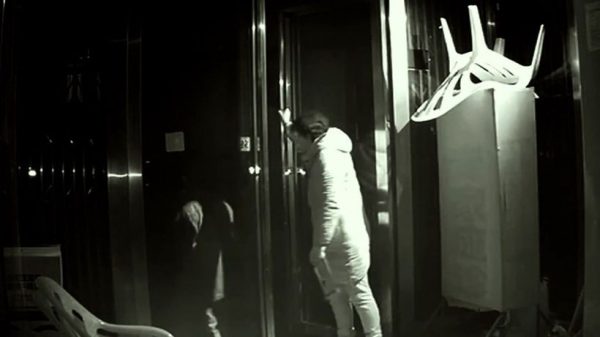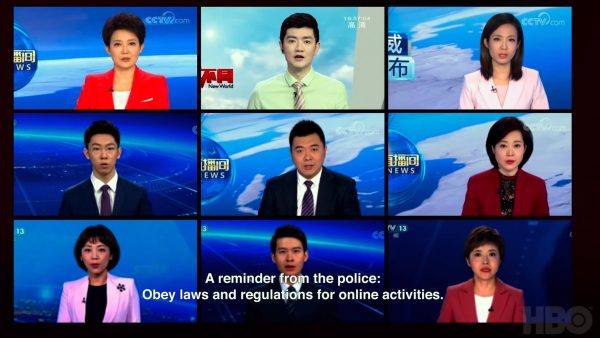In the Same Breath, 2021.
Directed by Nanfu Wang.

SYNOPSIS:
How did the Chinese government turn pandemic cover ups in Wuhan into a triumph for the Communist party?

If documentaries about ongoing subjects have a tendency to age poorly, that’s unlikely to hold true for Nanfu Wang’s (One Child Nation) monumental deep-dive into the beginnings of the COVID-19 pandemic in Wuhan, China.
With clarity and conviction, Wang details an avalanche of events – some you’ll know, others you won’t – which comprised the state’s aggressive and successful attempts to downplay the virus’ ravaging effects.
Given that most of the world is still in the throes of the pandemic today, it almost feels like a sick joke to venture back to the supposedly halcyon days of January 2020, though as we know now, the virus had already begun its wildly downplayed surge through Wuhan.
With an industrious efficiency, whistle-blowers were suppressed, social media policed, patients refused treatment without reason, activists suspiciously “disappeared,” and in one of the doc’s most damning accusations, it’s implied the official Wuhan death toll may be just 10% of the real figure. And all of this serves one simple truth: the Chinese state favours secrets and lies over actual information. But as Wang later argues, the west also has plenty of its own demons to deal with.
What elevates Wang’s film far beyond a mere capsule of “the story so far” is the staggering breadth of footage she was able to capture and acquire during the early stages of the outbreak, shrewdly hiring local camerapersons to slyly film throughout COVID-ridden hospitals, even leaving the cameras locked off, found footage-style, to capture unexpected sights.
The horrifying imagery is unsurprisingly myriad, and may simply be too much for some viewers; a distraught father desperately trying to speak to his unconscious son, or conversely, another man’s father taking his final breaths as he tells his son, “There’s no oxygen.”

Elsewhere there are phone calls with those who have lost family members, and harrowing glimpses of Wuhan’s medical infrastructure at breaking point, where people are left to triage their own dying relatives, deciding whether to leave them at a hospital with no beds or take them home to die.
It naturally doesn’t take long for the footage to point to a more sinister, underlying horror as hospital employees refuse to talk on the record, and interview requests require government approval. You can practically hear the state’s propaganda machine whirr into action at that moment, driven to control the “narrative” and preserve the delicate primacy of the monolithic state.
For western audiences, perhaps the most attention-grabbing section of Wang’s film delves into just how heavily propagandised Chinese state television is, lionising healthcare workers for doing their job with overwrought puff pieces, while sentimental human interest stories are pigeonholed in-between.
It’d be hilariously overwrought were it not so genuinely terrifying, and of course, once the coronavirus sweeps through the U.S., the Chinese media can’t resist the urge to praise “China’s superior system.” When we see nine separate news reports parrot the same government-mandated report word-for-word, it’s little surprise that one woman interviewed, who lost her husband to COVID, fights back tears while still proclaiming herself lucky to be Chinese.
As much as China is the focus, Wang does inevitably shift the discussion to the United States, taking irresistible pot-shots at Donald Trump’s early downplaying of the virus, and Dr. Fauci’s aged-like-milk comments about masks not being necessary. Even Wang herself attests to buying into the myth – the propaganda, even – of American exceptionalism, only to see America fall the same way China did.

In sharp contrast to the state-sanctioned spiel, Wang speaks to numerous American healthcare workers struggling to even keep a job due to speaking out against insufficient safety precautions at their hospitals. The trauma runs deep, exacerbated of course by anti-lockdown protestors making their jobs even harder.
Rather than dismiss the protestors as stupid or brainwashed, though, Wang wants to get to the heart of the matter, arriving at the intriguing conclusion that these people, deeply misguided though they are, are themselves fearing misinformation in an era where transparent data and news is tougher to come by than ever. Compared to China’s state censorship, it appears America’s much-ballyhooed “freedom of speech” does little to quell the flow of misinformation.
We’re all looking forward to returning to “normal” some day, but Wang rightly questions what normal will even mean on the other side of a pandemic that’s killed 2.2 million people (officially) at the time of press, and has mentally decimated large swaths of the medical community, let alone the rest of us. As Wang struggles to picture the coronavirus’ end while showing footage from a jam-packed Wuhan on January 1st of this year, it’s tough not to agree.
But Wang saves arguably her most powerful editorial feat for last, concluding her film by rewinding back to the start of the pandemic and theorising an alternate path for eradicating the virus. It sounds gimmicky, yet powerfully visualises the sentiment that most of the last year didn’t need to happen. It’s also tough to shake Wang’s haunting closing provocation, that China’s propagandised “success” at quashing the virus is really part of an endgame to legitimise authoritarian rule around the world.
An outstanding work of investigative journalism from Nanfu Wang, In the Same Breath is a terrifying and deeply upsetting testament to the power of propaganda and the dangers of unchecked nationalism. It’s tough to imagine a more urgent or important documentary right now – a damning indictment of a global tragedy spun into a point-scoring political exercise.
Flickering Myth Rating – Film: ★ ★ ★ ★ ★ / Movie: ★ ★ ★ ★
Shaun Munro – Follow me on Twitter for more film rambling.











